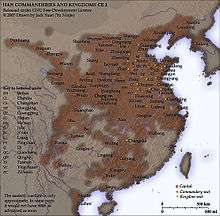Rinan
Rinan (Chinese: 日南, p Rìnán; Vietnamese: Nhật Nam), formerly known as Jih-nan, was the most southern commandery of the Han Empire. It was located in the central area of modern Vietnam between Quảng Bình and Bình Định provinces. It was administered by a local mandarin under direction from the capital of Jiaozhi at Leilou or Longbian (after c. AD 200) near modern Hanoi. It was part of Trưng Trắc's revolt in AD 39.

The concept of "Rinan" (lit "South of the Sun", referring to the Southern Hemisphere) was originally astronomical: above the Tropic of Cancer, the Chinese always faced south during religious ceremonies concerning the sun. In his Records of the Grand Historian, Sima Qian claimed the Qin Empire had spread so far as Rinan, where the houses faced north instead of south.[1] The Han claimed this conceptual region as early as 111 BC upon their conquest of Nanyue[2] but did not administer an actual district under the name until 48 BC.[1]
Under the Western Han, it was recorded as having 14,000 households or about 69,000 people. Several embassies from Rome (Da Qin) during the 1st and 2nd centuries – including one from Marcus Aurelius in AD 166 – are recorded as having come via Rinan, presumably by sea via India.[3]
In AD 264, during the division of Jiaozhou by the Emperor Jing of Wu, Rinan was placed under the new Jiaozhou.[2]
Counties
- Zhuwu
- Bijing
- Xijuan
- Lurong (Lô Dung)
- Xianglin (Tượng Lâm)
See also
References
- Trương Thái Du. "A New Approach on Old Issues of Ancient Vietnamese History". Institute of Vietnamese Studies.
- Vu Dinh Dinh. "Cochinchina: Reassessment of the Origin and Use of a Westernized Place Name". The Writers Post, vol. 9, Jan & Jul 2007.
- Hill, John E. Through the Jade Gate to Rome: A Study of the Silk Routes during the Later Han Dynasty, 1st to 2nd Centuries CE, pp. 27 ff. BookSurge (Charleston), 2009. ISBN 978-1-4392-2134-1.